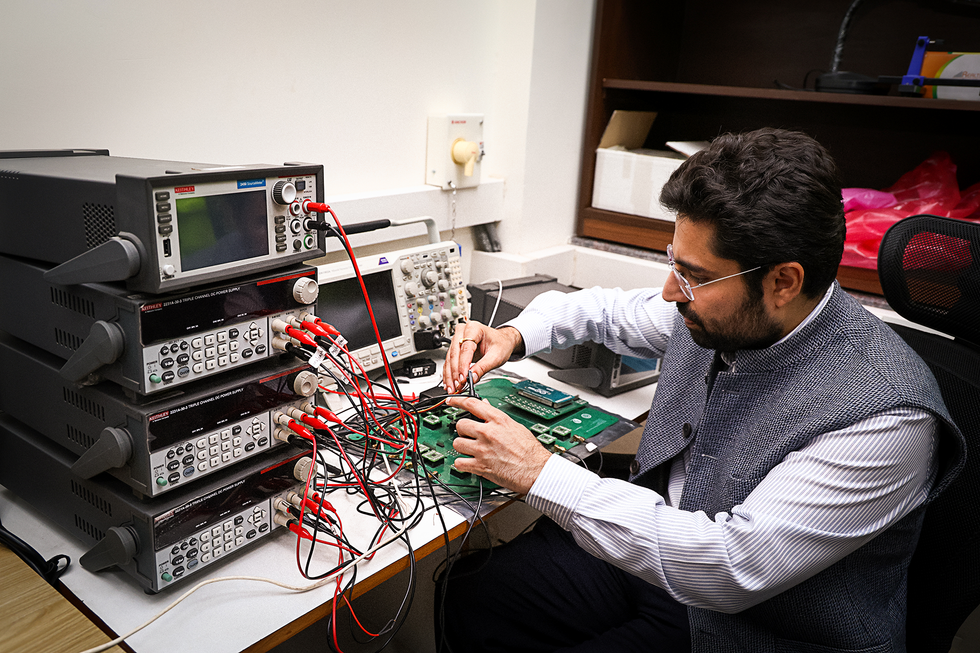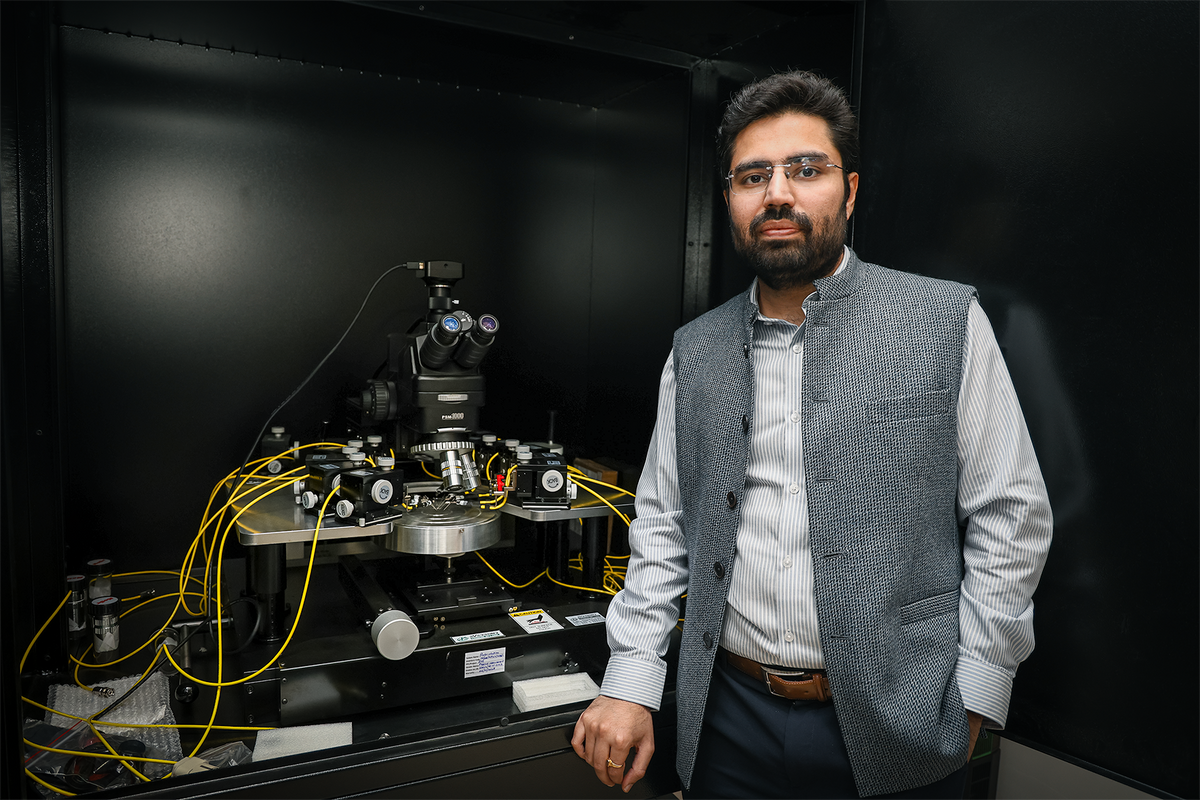In work and in life, it’s easy to get stuck in your ways. That’s why Manan Suri has always looked to expand his horizons both professionally and personally.
Growing up in India, he was used to transitions and new experiences because his family frequently moved around the country as his father relocated for his job as a chemical engineer. Traveling stuck with Suri in adulthood. He studied and worked in Dubai, the United States, France, and Belgium over the course of his twenties.
Manan Suri
Employer:
Indian Institute of Technology Delhi
Occupation:
Associate professor and founder of Cyran AI Solutions, New Delhi
Education:
Bachelor’s and master’s degrees in electrical and computer engineering, both from Cornell; Ph.D. in nanoelectronics from the CEA-Leti research institute in Grenoble, France
Eventually, Suri moved back to India to become an assistant professor at the Indian Institute of Technology Delhi. There he set up a research group focused on developing brain-inspired (neuromorphic) computer hardware for low-power devices like sensors, drones, and virtual-reality headsets. He is now an associate professor.
He also launched a startup to commercialize his lab’s expertise: Cyran AI Solutions, based in New Delhi, works with companies and government agencies on a variety of projects. These include automating the inspection process for identifying defects in semiconductors and developing computer-vision systems to improve crop yields and analyze geospatial Earth-observation data.
While balancing a career in academia and industry is challenging, Suri says, he relishes the opportunity to constantly learn.
“Once I’ve figured out how a system works, I start getting bored,” he says.
Suri, an IEEE member, believes that embracing change is a key ingredient for success. This is what has driven him to continually move on to new projects, push into new disciplines, and even move from country to country to experience a different way of life.
“It accelerates your ability to learn new things,” he says. “It puts you on a fast trajectory and helps shed some of your inhibitions or get over the inertia in what you’re doing or how you’re living.”
Inspired by Cornell’s semiconductor lab
Growing up, Suri’s passion was physics, but he quickly realized he was drawn more to the practical applications than theory. This led to a fascination with electronics.
In 2005 he initially enrolled at the Birla Institute of Technology and Science, Pilani, in India, and studied electronics and instrumentation at the institute’s campus in Dubai. After his second year, he transferred to Cornell, in Ithaca, N.Y. His first six months living in the United States, acclimating to a new culture and a different academic environment, were overwhelming, Suri says. What hooked him were Cornell’s high-end facilities available to students studying semiconductor engineering and nanofabrication—in particular, the industry-grade semiconductor clean rooms.
He earned a bachelor’s degree in electrical and computer engineering in 2009 and a master’s degree in the same subject the following year.
New skills in computational neuroscience
After graduating, Suri received offers for Ph.D. positions in the United States and Europe to work on conventional electronics projects. But he didn’t want to get pigeonholed as a traditional semiconductor engineer. He was intrigued by an offer to study neuromorphic systems at the CEA-Leti research institute in Grenoble, France. He was also eager to broaden his life experience and get a taste of the European way of doing things.
The work would push Suri to develop new skills in computational neuroscience and computer science. In 2010 he started a Ph.D. program in the institute’s Advanced Memory Technology Group. There he worked on low-power AI hardware that uses new kinds of nonvolatile memory to emulate how biological synapses process data. This involved using phase-change memory and conductive-bridging RAM to create neural networks for visual pattern extraction and auditory pattern sensitivity.
Suri discovered that his experience with electronics allowed him to approach neuromorphic engineering problems from an entirely different angle than his colleagues had considered. Experts can develop fairly rigid and conventional ways of thinking about their own field, he says, but when those with different skill sets apply them to the same problems, it can often lead to more innovative thinking.
“You bring a completely different perspective,” he says. “It leads to a lot of creativity.”
Setting up his own research lab
After finishing his doctorate in nanoelectronics, Suri got a job working on high-voltage transistors for automotive applications at the semiconductor designer NXP Semiconductors, in Brussels. Since his role was to take a project all the way from concept to fabrication, it was as close to pure research as he could get in industry. But as interesting as the work was, Suri says, he missed the intellectual freedom of academia.
When the opportunity of setting up his own lab at IIT Delhi came along, he jumped at it. He had also been away from his home country for almost a decade and wanted to be closer to family and contribute to the Indian science and technology ecosystem, he says.
“Most users don’t really care about what technology we are using. They just want functional performance at the most cost-effective price.”
“Moving abroad was more a matter of collecting experiences and seeing how different places work,” he says.
Suri’s group at IIT Delhi has made contributions to AI hardware, neuromorphic hardware, and hardware security. The group collaborates with industry research teams around the world, including Meta Reality Labs, Tata Consultancy Services, and GlobalFoundries.
Launching a startup
Despite returning to academia, Suri says he has always been interested in developing practical solutions to real-world challenges, and this goal has guided his research. Whatever project he works on, he always asks himself two questions: Will it solve a real problem? And will someone buy it?
Suri launched his startup in 2018 to turn some of his lab’s work in AI and neuromorphic hardware into commercial products. Cyran AI Solutions’ customers hire the company to solve a range of problems. These have included computer-vision systems for detecting defects in computer chips; hyperspectral data-analysis algorithms designed to run in real time on chips for crop-inspection drones; and AI systems for small, low-power devices and challenging environments like satellites.

While Cyran makes use of its neuromorphic expertise for some problems, it often uses more mature and simpler-to-deploy machine-learning approaches.
“Most users don’t really care about what technology we are using,” Suri says. “They just want functional performance at the most cost-effective price.”
One of the biggest lessons Suri learned from running a startup is to consider the market being served. For earlier projects, he says, the company often devised a solution that was specific to just one customer’s needs and couldn’t be repurposed for other uses. To create a sustainable business, he realized he needed to develop generic solutions that could be deployed more broadly.
“Running Cyran has been like [pursuing a] mini-MBA,” he says. “You need to really pay attention to the market aspects and not just the technology.”
In 2018, MIT Technology Review named Suri one of its 35 Innovators Under 35 for his work on neuromorphic computing.
The need to be hands-on
Keeping a foot in both academia and industry can be challenging, Suri says. Facing resource crunches, whether in time, staffing, or funding, is common. The only way he’s able to manage things is to plan extensively and remain nimble, building in contingencies.
If you can manage it, Suri says, having your fingers in many pies can have major benefits. In particular, working on problems that bridge several disciplines can help you break out of rigid thinking and come up with novel solutions.
It’s not possible to dedicate equal amounts of time to learning every area, he says, so he advises up-and-coming engineers to carefully pick the topics that are most likely to advance their progress. It’s also crucial to dive in and get your hands dirty, rather than focusing on theory, initially.
“Take the plunge and try and figure it out,” he recommends. “As the problem unravels, then you can start getting into the theory or the more formal aspects of the project. You also start to appreciate learning more about the theory as it gets more hands-on.”
- 35 Years Ago, Researchers Used Brain Waves to Control a Robot ›
- This Engineer Is Helping to Make India a Global Semiconductor Hub ›
- This Startup’s AI Tool Makes Moving Day Easier - IEEE Spectrum ›
Edd Gent is a freelance science and technology writer based in Bengaluru, India. His writing focuses on emerging technologies across computing, engineering, energy and bioscience. He's on Twitter at @EddytheGent and email at edd dot gent at outlook dot com. His PGP fingerprint is ABB8 6BB3 3E69 C4A7 EC91 611B 5C12 193D 5DFC C01B. His public key is here. DM for Signal info.



